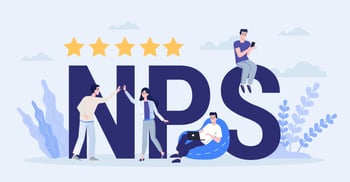16 Actionable Metrics for Measuring Customer Success in SaaS
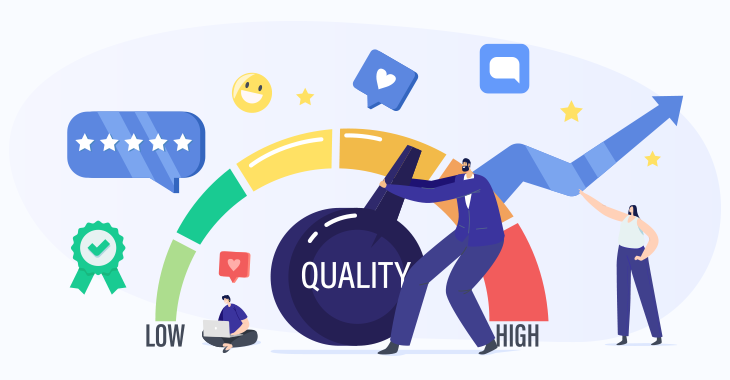
Any company with a customer base must develop a strong customer success strategy. But what exactly is - and how do you - measure customer success?
Apart from the many SaaS trends and tools entrepreneurs that sell SaaS online should stay on top of, there are so many different metrics out there that it can feel overwhelming. That’s why we at PayPro Global decided to clear up some of the confusion. This article will provide you with all the metrics you need to measure customer success within your Software as a Service (SaaS) business.
What Is the Definition of Customer Success?
Customer success is a business methodology about anticipating customer needs and challenges, as well as being proactive in terms of offering solutions.
This type of success involves multiple parts of your business. For example, are your customers happy with the way your product works? Are they using its full functionality? Are they satisfied with the value it adds to their lives? Do they understand the full value of your product?
Considering all these questions and more is the key to truly understanding and creating customer success.

The Importance of Measuring Customer Success Metrics in SaaS Businesses
Acquiring new customers, even SaaS free trial users for that matter, can be expensive and time-consuming, with most unlikely to be locked into lengthy contracts with your business. Good relationships with your existing customers are, therefore, critical, and keeping them happy can lead to longevity for your business.
Customer success is the key to your business’s overall success. If your customers “succeed” in using your product, they’ll continue using it. And, if they use your product successfully, your business will continue to grow. Happy customers are likely to convert from a free trial to a subscription, become regular users, and, with some luck, loyal advocates for your business. Figuring out whether or not to offer a flexible pricing strategy, improve your customer assistance and apply any other growth hacks should be a data-driven decision.
You need data in the form of customer success metrics and KPIs. Luckily, eCommerce partners value data just as much as you do, so joining forces with a strong payment provider will undoubtedly give you access to solid reporting tools. Read on to learn more.
16 Actionable Metrics for Measuring SaaS Customer Success
While understanding what is net revenue retention is useful in tracking your marketing efforts, the metrics outlined below are the most critical when measuring customer success for SaaS and so should form the basis of your success strategy. Track these metrics, and you’ll be able to tell how successful your customers are at using your product.
1. Customer Lifetime Value (CLV)
Customer Lifetime Value (CLV) represents the total revenue a business can earn from a customer over the lifetime of the relationship. It forms an essential link between customer success and subscription revenue.
If a customer’s lifetime value increases over time, they’re getting value from your product, which means your profits rise. Conversely, if the Customer Lifetime Value is decreasing, you’ll have to work out why the value or benefit of your product lessens over time, as it could hurt your profits.
To calculate customer lifetime value, you need three pieces of data:
Annual Revenue per Customer (ARPC)
Customer relationship (in years)
Customer Acquisition Cost (CAC)
Take your annual revenue per customer, and then multiply that by the number of years your customer has been with you. Finally, subtract the cost it took to acquire the customer, and you’re left with their Customer Lifetime Value.

An efficient customer success team focused on retaining customers will increase your ARPC and the average length of the customer relationship. In turn, these metrics will dramatically increase your CLV.
No 3rd party integrations. No hidden costs. No wasted time.
Just a solution as unique as your business’s needs.
2. Repeat Purchase Rate (RPR)
Your Repeat Purchase Rate (RPR) refers to if your customers continue to do business with you or not. This rate can include subscription renewals and whether they remain with your company or move to a competitor.
To calculate your RPR, you’ll need to know how many customers made a repeat purchase over a set period of time (let’s say a year) and the total number of customers over that same year.
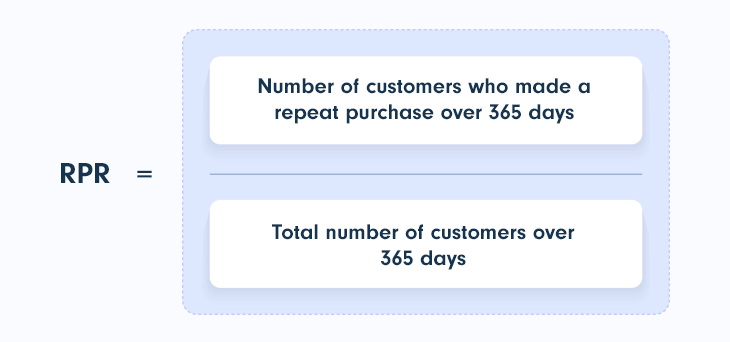
To increase your RPR, you’ll have to increase the number of repeat purchases being made. Increasing your repeat purchase rate will positively and directly affect your CLV, meaning more revenue for you over time.
3. Customer Acquisition Cost (CAC)
Your CAC refers to the cost of acquiring a new customer. This metric typically includes expenses such as research, marketing, even SaaS user onboarding, and advertising costs. It can also consist of the salaries of your sales and marketing employees.
To calculate your CAC, you must divide the total number of sales and marketing costs of your SaaS product by the number of new customers acquired over a certain period.
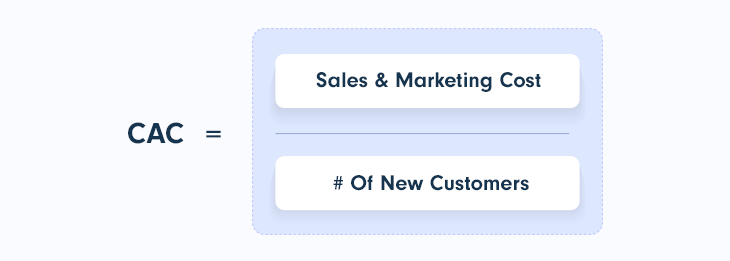
CAC is one of the more important SaaS customer success metrics when it comes to predicting growth, helping you determine the long-term health of your business. Once you've calculated this metric, you can figure out what your CAC payback period (the time it takes to recover your CAC costs) is. Also, without looking at this value, you won’t know for sure if your subscription marketing strategy is effective or not. Calculating your CAC helps you to determine the resulting return on interest (ROI) of an acquisition.
4. Customer Retention Rate (CRR)
Customer Retention Rate (CRR) is another one of the critical customer success metrics for businesses that value ongoing relationships, making it an essential value for SaaS businesses like yours.
That is because CRR measures the percentage of customers your business retained over a period of time. In other words, it tells you how many are sticking with you, rather than churning.
To calculate customer retention rates, you’ll need to take the volume of customers you had at the end of a given period and subtract it by the number of new customers you acquired over that time. Take that figure, then divide it by the volume of customers you had at the beginning of that same period, then multiply that by one hundred.
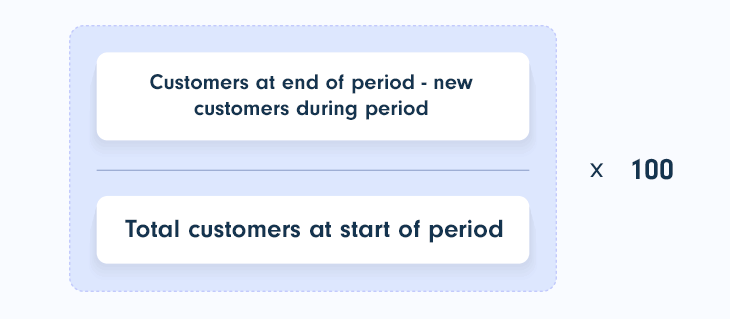
5. Customer Retention Cost (CRC)
Customer Retention Cost (CRC) is the amount your business must invest in keeping a customer. This metric is very effective in helping you understand your customer’s success.
An effective success strategy will grow customer retention at a greater rate than the cost of implementing the plan. It also helps you understand whether your customer retention cost is high enough to justify your customer success and SaaS retention spending. Finally, customer success metrics like this will help you figure out whether your efforts to keep your customers on board and spending are working effectively.
To calculate customer retention cost, you need the total number of annual costs spent on customer success and retention initiatives as well as the number of current active customers. The calculation looks like this:
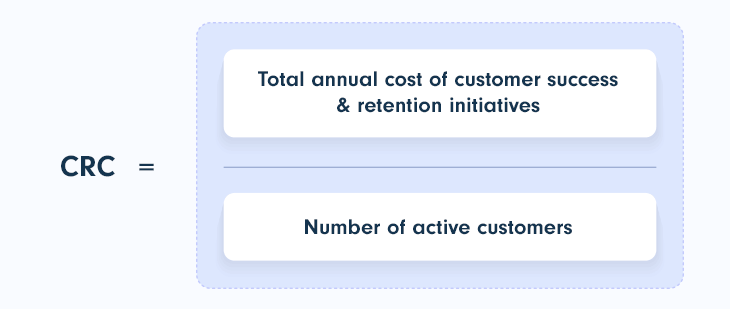
6. Customer Churn Rate (CCR)
Customer Churn Rate (CCR) measures how many customers your business loses over time. The churn rate is calculated either monthly or annually and can refer either to the number of customers lost or the amount of money (revenue churn) the customers would have represented.
To accurately work out your precise customer churn rate, it’s critical to define what a churned customer looks like to your business. First, you’ll have to decide how to count customers and how you define the moment of churn. Then, you have to apply your definition consistently.
To calculate the number of churned customers, you need to know how many customers you had at the beginning of a month and how many were lost (churned) during that same period. See the calculation below:
There is no one size fits all answer when it comes to determining what makes a good churn rate. And while it's important to reduce customer churn, you won't be able to do so completely. Most in the industry consider a 3-5% monthly to be a typically “good” churn rate for SaaS companies targeting smaller businesses. However, the larger the businesses you work with, the lower your churn rate has to be. This is to account for the fact there is a smaller number of them in the market. Given the uncertain nature of the SaaS market, keeping an eye on this metric is essential. You must have prepared effective digital engagement strategies that help you reduce customer churn.
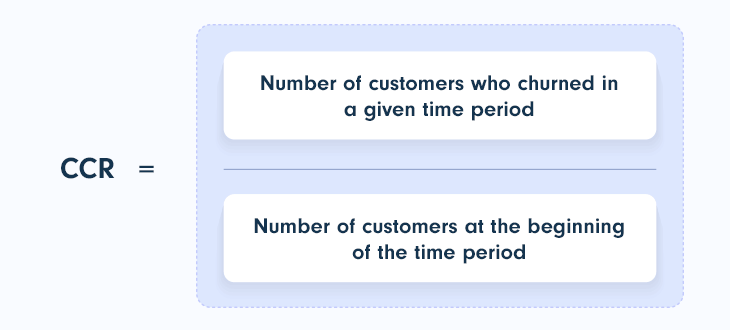
7. Net Promoter Score (NPS)
The Net Promoter Score (NPS) is a very different metric from the others discussed so far. It’s based on customer responses to a specific net promoter score survey. The survey will have only one question, which asks something like this: “How likely are you to recommend [insert your business here] to a friend?” This question is then accompanied by a scale ranging from 1 to 10.
Businesses take this data and assign names to different groups of respondents. Those who click 0-6 are called “detractors,” those who click 7 and 8 are “passives,” and those who click 9 and 10 are “promoters.”
These scores are displayed as numbers between -100 and +100. You calculate the score by finding the difference between the percentage promoters and the percentage detractors (% promoters - % detractors).

Net promoter scores are cost-effective metrics because surveys are easily incorporated into campaigns. NPS surveys are low admin as they can take less than 30-seconds to complete.
As an indication of business success, a good NPS score means higher recurring revenue, retention rates, and customer satisfaction. Happy customers are more likely to refer you to their friends. These referrals are converted into leads and, eventually, revenue.
8. Customer Satisfaction Score (CSAT)
Your Customer Satisfaction Score (CSAT) is also based on customer feedback, however, the main difference between this and NPS is that CSAT is considered a short-term evaluation of customer happiness useful for targeted improvements, while NPS is much of a long-term indication of customer loyalty.
While companies use their Net Promoter Score to determine overall customer satisfaction, they use a Customer Satisfaction Score to get data on specific product features.
This metric is all about how your customers rate their experience with your business. This score can be pretty flexible and include many different aspects, depending on what questions and rating scales you use.
To calculate your CSAT, you need to design a customer satisfaction survey unique to your business. For example, you could ask customers: “How satisfied were you with the service you received on X product?”

Once you have the answers, single out the positive responses and divide them by the total number of responses. Now convert this into a percentage.
9. Customer Effort Score (CES)
No one likes having to put large amounts of effort into tasks. It’s human nature to take the path of least resistance. Customer Effort Score (CES) measures how much effort your product requires from customers — the lower the effort score, the better.
Harvard Business Review states that, for most customers, reducing effort builds loyalty and can improve customer service, reduce costs, and decrease churn. These factors make it one of the more vital customer success metrics.
How should you calculate your CES? First, you’ll need to use a survey statement along the lines of “[Insert business here] made it easy to resolve my issue].” This statement should be accompanied by a rating scale — for example, from 1-7. Now, work out the average rating to get your CES.
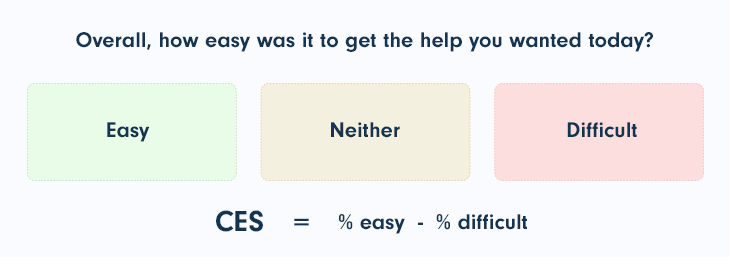
10. Customer Health Score (CHS)
The Customer Health Score (CHS) is a metric that’s used to determine whether a customer is “healthy” or “at risk.” This metric can predict the likelihood of how a relationship with a particular customer may change in the future.
A customer health score will change based on the unique specifications of your business. Your choice of what to measure will depend on a specific outcome. Are you losing customers? Or do you have a solid customer base but are looking to upsell to customers? Your measurements could be based on the success of their businesses or the frequency, breadth, and depth with which they use your SaaS product.
From this data, you can develop a customer health score scale. This scale will make your customer’s scores meaningful and valuable to your business. Usually, companies use a scale of between 1 and 100.
Once you have this score, you can use it to incentivize “unhealthy” customers — for example, by offering free access to certain features. In turn, you can upsell your healthy customers — for instance, by offering them premium subscriptions.
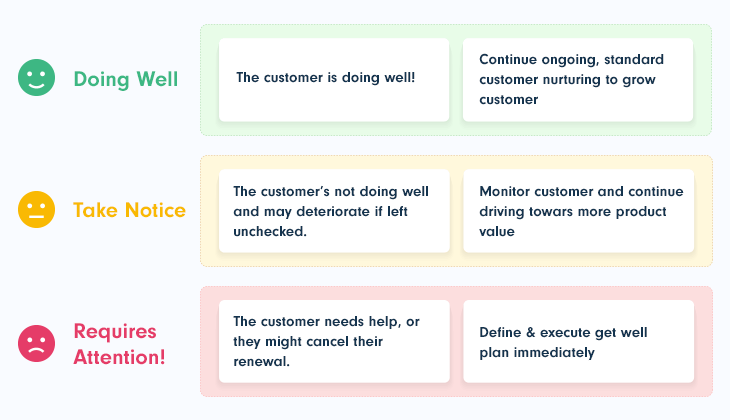
11. Monthly Recurring Revenue (MRR)
This metric measures the amount of money your customers are spending on your products and services each month. You can use your Monthly Recurring Revenue (MRR) to determine whether their spending has grown since working with your business.
In addition, this metric helps to determine whether your customers are succeeding with your products or not. The MRR is a handy tool for SaaS companies that work on a subscriptions basis.
To calculate your monthly recurring revenue, you’ll need to know your active customers per month and the average revenue each customer brings in. Now multiply the active customers by the average revenue.

Calculating your MRR makes it possible to determine whether your customers are using your product to its fullest extent and finding value from it.
12. Average Revenue per Account (ARPA)
This customer success metric represents the monthly revenue your business will get from each customer. Average Revenue per User / Account (ARPA) helps your business identify purchasing SaaS trends for various user groups over different periods.
To calculate your average revenue per user, divide your monthly revenue rate by the number of users you had over that time.
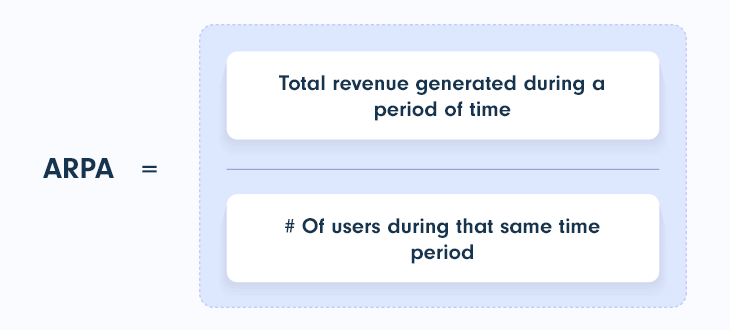
13. Renewal Rate (RR)
For SaaS businesses, Renewal Rate is a vital metric. As most SaaS businesses operate with subscription models, checking how many customers are signing up and renewing their subscriptions is critical for success.
Luckily, this is an easy metric to calculate: Divide your number of renewals by the number of customers eligible to renew in a certain period. Now convert this to a percentage.
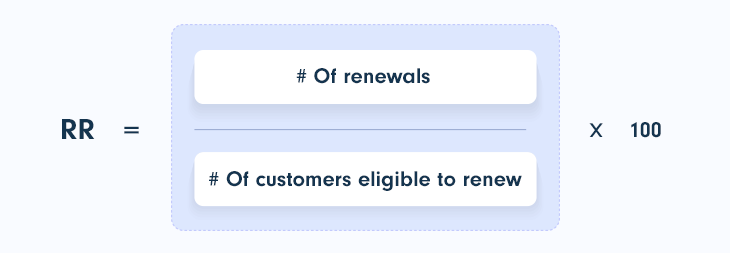
What does the Renewal Rate tell you? If the rate is high, you’re doing well at customer success. If it’s low, then simply put, your customers aren’t renewing their subscriptions. Working out why should be your primary focus, possibly using one of the previous customer success metrics, such as Net Promoter or Customer Effort Scores.
14. Conversion Rate (CR)
Conversion Rate (CR) refers to how many customers sign up for your SaaS product or switch from the free trial to the paid version. You want to maximize your CR to grow your business.
The conversion rate is a simple metric to calculate. Divide the number of sign-ups by the total number of visitors to your website or eCommerce platform.
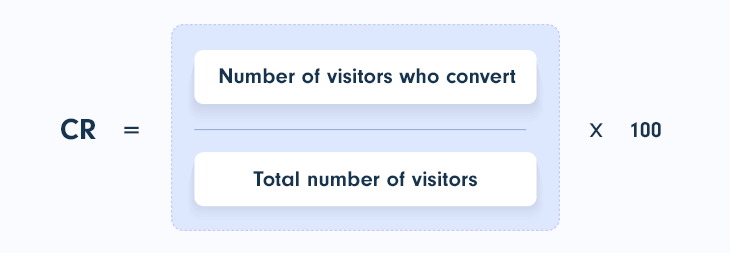
15. Daily or Monthly Active Users (DAUs / MAUs)
Daily Active Users (DAUs) or Monthly Active Users (MAUs) refer to the amount of activity from your users. These metrics can help you determine how many unique users are using your product over a specific period.
To calculate your DAUs or MAUs, you’ll have to decide what counts as an active user (e.g., someone who opens the app and engages with the product). Now you can work out how many you have on a monthly or daily basis.
These metrics can be good indicators of growth, stagnation, or user decline. There is no technical formula for DAU, as tools like Google Analytics can easily show you your daily active users. However, If you only have monthly traffic/usage data, you just take the total number of unique users and divide it by the days in the month.
No 3rd party integrations. No hidden costs. No wasted time.
Just a solution as unique as your business’s needs.
16. Time to First Value (TTFV)
Time To First Value (TTFV) helps you understand how successful your SaaS customer onboarding process is. This metric represents the time it took between a customer signing up the point at which the customer is deriving value from your product, rather than just learning how to use it. To achieve this, you need to aim for as short a TTFV as possible, making sure that your onboarding process is efficient and the customer sees value very quickly.
Companies with more complex products will generally have a longer TTFV. For example, powerful editing software may have a longer TTFV than a dating app. The longer TTFV isn’t always a cause for concern. If the customer is happy with the value they’re receiving from your SaaS product, they’ll be satisfied with the time it takes them to get there.
Final Thoughts on the Benefits of Using Metrics for Measuring Customer Success in SaaS Businesses
These customer success metrics form the beginning of a well-rounded customer success strategy for your SaaS business. You’ll need to choose which metrics are important for your business, as these tend to differ from one business to another.
The data you mine using these metrics will help you uncover areas that require more in-depth research and measurement. With this information in hand, you can move into more qualitative research. Investing time and energy into tracking how you measure customer success and understanding the people who use your product will help you grow your business. But you must rely on a strong partner offering strong reporting capabilities instead of working with a payment provider stalling SaaS growth.
Do you sell video games online? How about eBook, software, or SaaS? Need help? Making the most of your metrics is as simple as getting in touch with PayPro Global. Data is the driving force behind our full-service eCommerce toolkit, helping our partners develop the full revenue potential of their SaaS, Software, and digital goods. Through strong payment tools, ensuring global SaaS compliance, complete tax and subscription management, and faster transactions, PayPro Global is the partner you need to grow.
FAQ
Which metrics best measure Customer Success?
Net Promoter Score (NPS), Customer Health Score (CHS), and Customer Lifetime Value (CLV) are important metrics to help your company measure the success of their business.
What is the difference between KPI and metrics?
KPIs can help you see what's working well in your company and identify areas that need improvement; however, without tying them to an objective they're just numbers on a spreadsheet!
What are consumer metrics?
Consumer metrics are the measurements or stats businesses collect to find out what's happening with their customers.
Specific examples may include information like customer acquisition costs and conversion rates for different marketing channels, as well as engagement statistics on a website/social media platform.
Hanna Barabakh
Hanna Barabakh is a language and content specialist passionate about SaaS, technology, and e-commerce. Her expertise in multilingual content, connected to her background in Lexicography and Translation Studies, allows her to communicate complex ideas across cultures easily. She uses her knowledge to create engaging content that resonates with global audiences. In her spare time, she enjoys reading and exploring new ideas.
-
1.Explore PayPro Global's Solutions: See how our platform can help you streamline your payment processing and boost revenue.
-
2.Get a Free Consultation: Discuss your specific needs with our experts and discover how we can tailor a solution for you.
-
3.Download our Free Resources: Access valuable guides, checklists, and templates to optimize your online sales.
-
4.Become a Partner: Expand your business by offering PayPro Global's solutions to your clients.
Get the latest news

